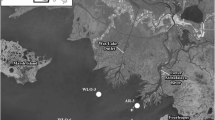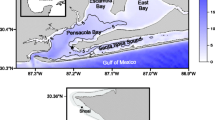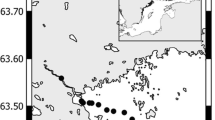Abstract
Percent respiration was measured in over 1,100 arctic and subarctic marine water and sediment samples using14C-labeled glucose and glutamate. These measurements were made at different times of the year in 4 regions. Percent respiration values were typically lower in regions where the waters of large rivers mixed with seawater. They were also lower in sediments and in waters collected near the bottom than in surface waters. They were higher in winter arctic waters than water samples collected in the summer; however, a similar seasonal trend was not observed in subarctic waters. There were a number of studies in which there were significant positive rank correlations between percent respiration and salinity and between percent respiration and temperature. From what is known about the range of temperature and salinity encountered in samples collected during these studies and the results of temperature and salinity effects experiments, it was concluded that changes in these 2 variables did not explain the variation observed in percent respiration. Correlations between percent respiration and the inorganic nutrients PO4 −3, NH4 + and NO3 − showed that of the 3 variables, only NO3 − showed relatively high correlations with all the same sign. From this it was concluded that there may be situations in which NO3 − levels may influence percent respiration in nearshore marine waters. It is also likely that qualitative characteristics of the available organic nutrients may also influence percent respiration levels. Although no organic nutrient data is available for statistical analysis, the patterns of percent respiration near river plumes and the relatively strong negative correlation often observed between uptake rates (heterotrophic activity) and percent respiration suggests that organic nutrients may be a factor in controlling percent respiration. It is suggested that there are situations in which percent respiration measurements may be used to document stress in natural microbial populations due to nutrient deficiencies.
Similar content being viewed by others
References
Baross JA, Hanus FJ, Griffiths RP, Morita RY (1975) Nature of incorporated14C-labeled material retained by sulfuric acid fixed bacteria in pure cultures and natural aquatic populations. J Fish Res Can 32:1876–1879
Bell CR, Albright LJ (1981) Attached and free-floating bacteria in the Fraser River estuary, British Columbia, Canada. Mar Ecol-Prog Ser 6:317–327
Burnison BK, Morita RY (1974) Heterotrophic potential for amino acid uptake in a naturally eutrophic lake. Appl Microbiol 27:488–495
Crawford CC, Hobbie JE, Webb KL (1974) The utilization of dissolved free amino acids by estuarine microorganisms. Ecology 55:551–563
Gillespie PA, Morita RY, Jones LP (1976) The heterotrophic activity for amino acids, glucose and acetate in Antarctic waters. J Oceanogr Soc Jpn 32:74–82
Gocke K (1976) Respiration von gelösten organischen verbindungen durch natürliche mikroorganismen-populationen. Ein vergleich zwischen verschiedenen biotopen. Mar Biol 35:375–383
Griffiths RP, Caldwell BA, Broich WA, Morita RY (1981) Long-term effects of crude oil on uptake and respiration of glucose and glutamate in arctic and subarctic marine sediments. Appl Environ Microbiol 42:792–801
Griffiths RP, Hanus FJ, Morita RY (1974) The effects of various water sample treatments on the apparent uptake of glutamic acid by natural marine microbial populations. Can J Microbiol 20:1261–1266
Griffiths RP, Hayasaka SS, McNamara TM, Morita RY (1977) Comparison between two methods of assaying relative microbial activity in marine environments. Appl Environ Microbiol 34:801–805
Griffiths RP, Hayasaka SS, McNamara TM, Morita RY (1978) Relative microbial activity and bacterial concentrations in water and sediment samples taken in the Beaufort Sea. Can J Microbiol 24:1217–1226
Griffiths RP, McNamara TM, Steven SS, Morita RY (1981) Relative microbial activity and mineralization associated with water masses in the lower Cook Inlet, Alaska. J Oceanogr Soc Jpn 37:227–233
Griffiths RP, Morita RY (1981) Study of microbial activity and crude oil-microbial interactions in the waters and sediments of Cook Inlet and the Beaufort Sea. In: Environmental Assessment of the Alaskan Continental Shelf. National Oceanic and Atmosopheric Administration pp 361
Hanson RB, Gardner WS (1978) Uptake and metabolism in two amino acids by anaerobic microorganisims in four diverse salt-marsh soils. Mar Biol 46:101–107
Hanson RB, Snyder J (1980) Glucose exchanges in a salt marsh-estuary: Biological activity and chemical measurements. Limnol Oceanogr 25:633–642
Hanson RB, Wiebe WJ (1977) Heterotrophic activity associated with particulate size fractions in aSpartina alterniflora salt-marsh estuary, Sapelo Island, Georgia, USA, and the continental shelf waters. Mar Biol 42:321–330
Hollibaugh JT (1978) Nitrogen regeneration during the degradation of several amino acids by plankton communities collected near Halifax, Nova Scotia, Canada. Mar Biol 45:191–201
Hoppe HG (1978) Relations between active bacteria and heterotrophic potential in the sea. Netherlands J Sea Res 12:78–98
Jørgensen NOG, Lindroth P, Mopper K (1981) Extraction and distribution of free amino acids and ammonium in sediment interstitial waters from the Limfjord, Denmark. Oceanol Acta 4:465–474
Lees DC (1978) Reconnaissance of the intertidal and shallow subtidal biotic lower Cook Inlet. In: Environmental assessment of the Alaskan continental shelf. National Oceanic and Atmospheric Administration pp 179–506
Morita RY, Griffiths RP, Hayasaka SS (1977) Heterotrophic activity of microorganisms in Antarctic waters. In: Llano GA (ed) Adaptations within Antarctic Ecosystems. Gulf Publishing Co, Houston pp 99–113
Nie NH, Hill CH, Jenkins JS, Steinbrenner K, Bent DH (1975) SPSS: Statistical Package for the Social Sciences. 2nd ed. McGraw-Hill, Inc, New York
Rowe K, Brenne R (1981) Statistical Interactive Programming System (SIPS). Statistical Computing Report No 7. Oregon State University, Corvallis
Stevenson LH, Erkenbrecher CW (1976) Activity of bacteria in the estuarine environment. In: Wiley M (ed) Estuarine Processes, Vol 1. Academic Press pp 381–394
Tison DL, Pope DH (1980) Effects of temperature on mineralization by heterotrophic bacteria. Appl Environ Microbiol 39:584–587
Valdes M, Albright LJ (1981) Survival and heterotrophic activities of Fraser River and Strait of Georgia bacterioplankton within the Fraser River plume. Mar Biol 64:231–241
Williams PJLeB (1970) Heterotrophic utilization of dissolved organic compounds in the sea. I. Size distribution of population and relationship between respiration and incorporations of growth substrates. J Mar Biol Ass UK 50:859–870
Wood LW, Chua KE (1973) Glucose flux at the sediment-water interface of Toronto Harbour, Lake Ontario, with reference to pollution stress. Can J Microbiol 19:413–420
Author information
Authors and Affiliations
Rights and permissions
About this article
Cite this article
Griffiths, R.P., Caldwell, B.A. & Morita, R.Y. Observations on microbial percent respiration values in arctic and subarctic marine waters and sediments. Microb Ecol 10, 151–164 (1984). https://doi.org/10.1007/BF02011422
Issue Date:
DOI: https://doi.org/10.1007/BF02011422




